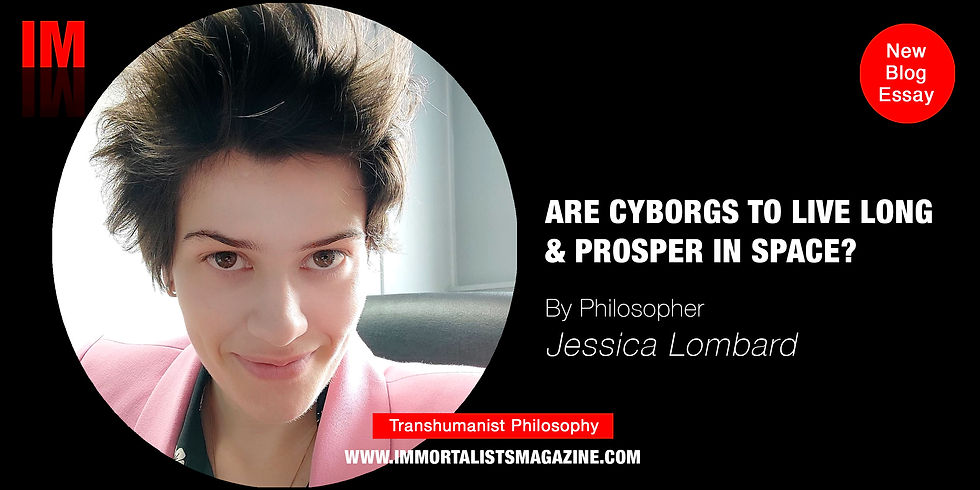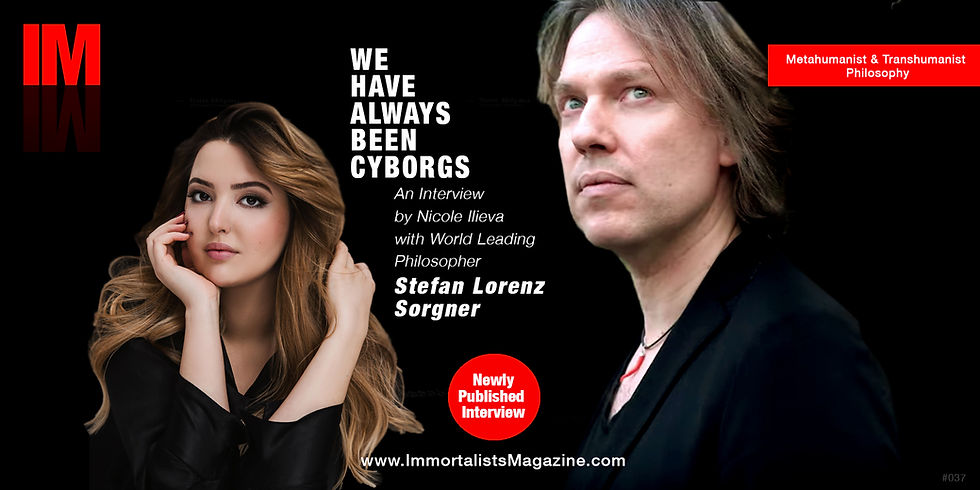Are Cyborgs to Live Long & Prosper in Space? By Jessica Lombard
- IM Bot

- Sep 1, 2022
- 5 min read
Updated: Sep 23, 2023

Edited by Dinorah Delfin
Merging with machines or the digital realm is a hot topic of discussion in the fields of transhumanism, posthumanism, evolutionary biology, and technological studies.
“Is it right, is it wrong?”
It is rarer, however, to hear the not-less-important question: What does “cyborg” exactly mean and how is it relevant today?”
This essay aims to answer this rightful question. We do not draw conclusions on what the majority of people or specialists call a “cyborg” today. We explain what was the original use of the term “cyborg” and in what context, and we briefly extend this question to the notion of the cyborg’s environment, inspired by the work of German philosopher, Peter Sloterdijk.
“Cyborg” is a confusing but highly prolific word. Currently, we can note at least four definitions that are sometimes contradictory and still open to debate:
1. The fusion of added organic and cybernetic elements in the human biological body.
2. An ontological feature that describes humans’ way of interacting with the environment.
3. A future weapon economically and military-backed.
4. The last state of mankind, with fully increased potential through technosciences.
Each of these definitions allows us to put into perspective what the term cyborg is and how it was originally used.
Historically, the word “cyborg” stands for “cybernetic organism”. It was coined by Manfred E. Clynes and Nathan S. Kline in 1960 (this is not a new revolutionary word indeed) and popularized in their article “Cyborgs and Space”. Moreover, it was used to feature a very specific condition of the human being related to space exploration and adaptation.
Space exploration was a very special topic during the 1950s and ’60s. There was the launch of the first artificial satellite Sputnik (1957), which successfully return signals from space; and the first human-crewed orbital flight by Yuri Gagarin (1961). Last but not least, the original series of the Star Trek TV show began in 1966.
As the beginning of space exploration led to major changes in scientific, political, social, artistic, and philosophical paradigms, the question of Clynes and Kline seems all the more so understandable:
“Biologically, what are the changes necessary to allow man to live adequately in the space environment?”
Their postulate was that it should be easier to modify the human body to live in space than to modify space to permit human life. “Altering man's bodily functions to meet the requirements of extraterrestrial environments would be more logical than providing an earthly environment for him in space.” Usually, the will to change environmental conditions rather than human organisms is a common food for thought; for instance with artificial atmospheres encapsulated in diverse sorts of enclosure. Clynes and Kline believed it was both dangerous and temporary solutions, for “the bubble all too easily bursts.”
As a result, they proposed the idea of human enhancement in space and introduced the term “cyborg”. “Cyborg” was referring to the self-sufficiency of the human organism once it had been improved through technological means, in order to sustain interstellar life conditions in total autonomy.
This word referred to the incorporation of exogenous components that extends the self-regulatory control function of the organism in order to adapt it to new environments. Interestingly enough, the article adds the following precaution; “without alteration of heredity.” Clynes and Kline were aware of the religious and secularized sacralization of a human “nature” that deeply underpinned our societies. However, they still endorsed the use of new technological means, suitable biochemical, physiological, and other electronic modifications of the human's existing modus vivendi, such as osmotic pressure pump capsule for continuous slow injections of biochemically active substances at a biological rate.
Now that “cyborg” is a clearer concept, it is time to expand on the question of the cyborg’s environment. The notion of autonomy and self-sufficiency of this enhanced organism can be appealing in itself, but we argue that it may not be enough.
For Peter Sloterdijk, humans, be it culturally or technically, create desirable environments to co-exist in the already existing one. We never live outside the physis (nature, in an ontological sense), but we forge a proper existential space around us, through a vast series of interconnected fields that both shelters and creates us – politics, economy, technology, religion, art, architecture, philosophy, etc.
Sloterdijk was greatly interested in space exploration, and more precisely the question of spaceships. For him, human-crewed interstellar flights constitute one of the (if not the) most important enterprise of our time.
Space is a place where there is no human presence. Aboard a spaceship, it is not just the human crew that adapts to its environment, but also the spaceship that is entirely built to adapt itself to the environment, in order to sustain life. A spaceship embodies a prosthetic dwelling where the environment is controlled and regulated in order to protect and strengthen human lives.
It is the absolute model of “the world within the world” that aims to radically and eccentrically build the premise for life in space.
We believe it is crucial to at least consider the idea of solving the technical problems involved in manned space flight by adapting the human being to his environment, rather than vice versa. This “cyborg enterprise” will not only mark a significant step forward in mankind’s scientific progress, but it may provide a new and larger dimension for the human understanding of himself as well. However, we also believe that a cyborg cannot be self-sufficient and thrive in a hostile environment. A cyborg also needs its own space, its own environment to rely on, and a society built around him – just as Sloterdijk’s elucidates in his philosophical understanding of the spaceship.
Whether we engage in space colonization for opportunities, exploration, or the need to flee Earth due to an existential threat, developments in advanced bio-sciences and technologies could allow humans to re-adapt and thrive in not just extraterrestrial environments but also on our own planet.
Space travel and cyborg-related technologies challenge mankind technologically and intellectually by questioning the role of humans in our own evolution. Clynes and Kline remind us; that “in the past, (biological) evolution brought about the altering of bodily functions to suit different environments.” If space exploration or environmental degeneration on planet Earth threatens humans' ability to thrive, we should begin to consider what “adapting” really entails.
A Question For IM Readers:
Why is being a Cyborg relevant today?
Please share your thoughts below!
About the Author:
Jessica Lombard is a Philosopher & former Lieutenant. Ms. Lombard graduated from the Special Military School of Saint-Cyr (France) & obtained her philosophy degree in Paris (ENS-EHESS). Currently works as a PhD researcher for the FINO Consortium (Italy) focusing on technology and transhumanism in the field of metaphysics and phenomenology.




Comments